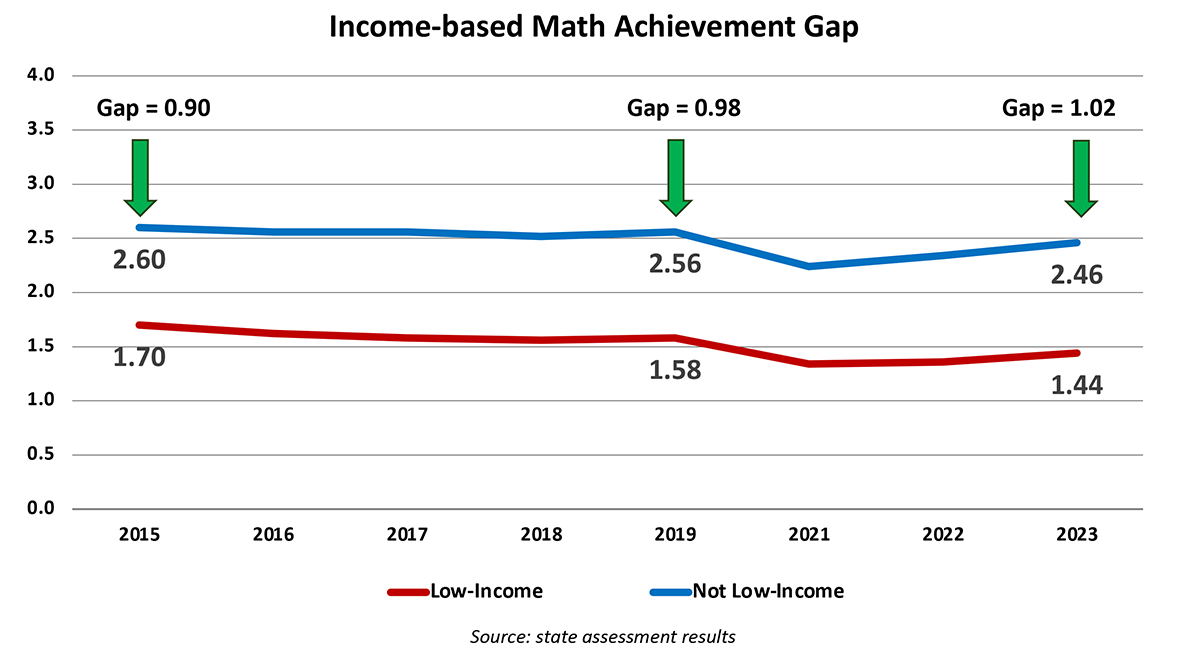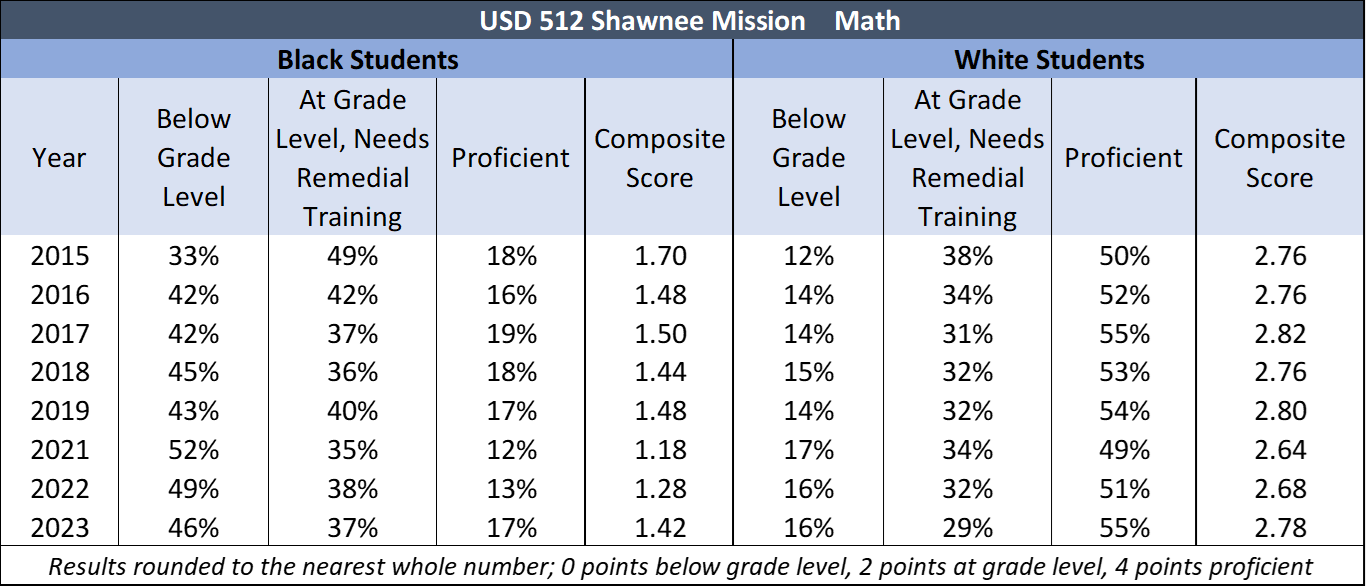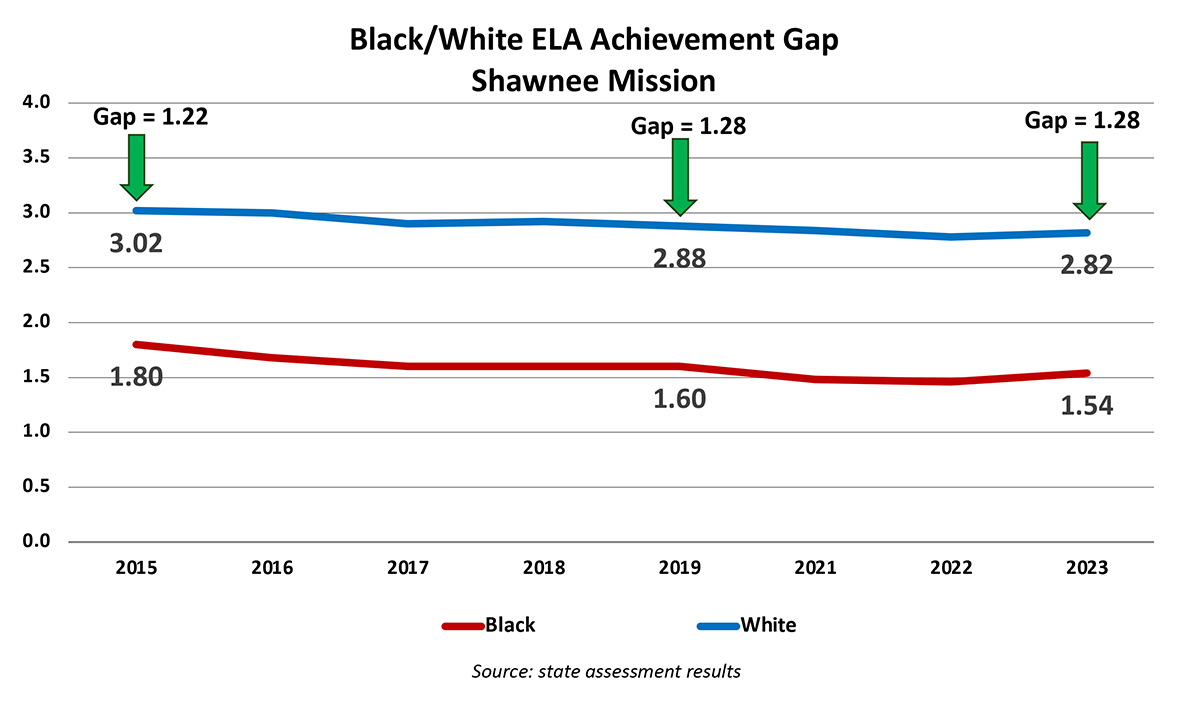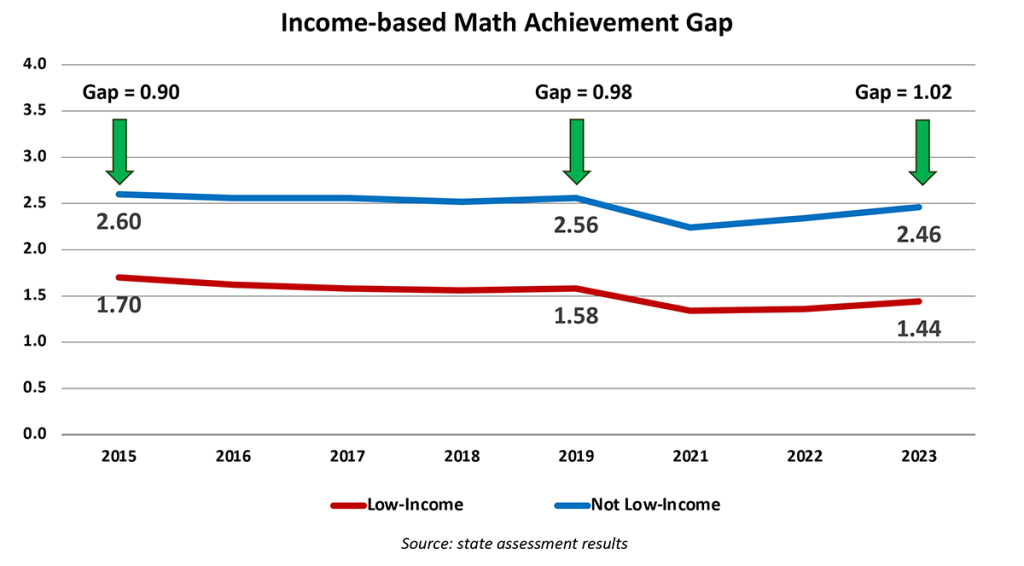Minorities and low-income students are falling further behind despite Kansas taxpayers giving school districts $3.8 billion in at-risk funding since 2015 to improve outcomes and close achievement gaps on the state assessment. At the same time, many school districts implemented diversity, equity, and inclusion (DEI) training, theoretically, to improve minority outcomes and close achievement gaps. Sadly, those gaps also expanded.
There are four levels of state assessment scores. Level 1 is below grade level, Level 2 is at grade level but needs remedial training, and Levels 3 and 4 are proficient. Measuring trends in achievement gaps with three moving variables is difficult, so we convert outcomes to a single score.
We apply zero points to Below Grade Level, two points for At Grade Level, and four points for Proficient. The scores are weighted according to the share of students in each category, as shown in this example. Two points times 35% (At Grade Level) is a score of 0.70, plus four points times 30% (Proficient) produces a composite score of 1.90.

This table shows the math composite scores for low-income students and those who are not low-income for each year the current state assessment has been administered. Both demographic groups have more students below grade level now than in 2015, and proficiency is one point lower for both groups. The shares of students at grade level declined in both cases, but that can be good or bad; achievement declined if students moved to the below grade level category, but moving to proficient is an improvement. The composite score methodology puts achievement gaps into a context that is easier to see.

Low-income students had a 1.70 composite score in 2015, compared to 2.60 for other students, putting the achievement gap at 0.90. Now, the gap is wider at 1.02, with low-income students falling to a 1.44 composite and the other group at 2.46.
This chart shows the gap was wider in 2019 (pre-COVID). Results for 2023 are still below pre-pandemic levels, and the gap increased again.

The income-based gap for English Language Arts is also a little worse than in 2015 and 2019.

School funding has dramatically increased since 2015, which school officials often claimed was needed to close achievement gaps, but just spending more hasn’t made a difference.
Some education officials believe minority students have lower outcomes because they don’t feel ‘included’ and have devoted a lot of time and money to diversity, equity, and inclusion (DEI) initiatives, but that also has not worked.
No evidence that DEI closes minority achievement gaps
USD 512 Shawnee Mission is preoccupied with DEI. It permeates the district’s strategic plan (that only gives lip service to improving outcomes). The Shawnee Mission board was an early adopter of Corwin Publishing’s Deep Equity training, which is based on critical race theory.
Corwin’s Deep Equity program is based on the work of Gary Howard, who believes White people “are collectively bound and unavoidably complicit in the arrangements of dominance that have systematically favored our racial group over others.”
The premise of Deep Equity is that minority student achievement is suppressed by White privilege. Corwin says, “The dynamics of privilege and power must be confronted to impact real change,” and “students’ cultural realities and experiences must be at the center of the teaching and learning process.”
Yet achievement gaps for Black students are worse, as math outcomes for Black students declined while White students slightly improved. In 2015, 33% of Black students were below grade level and 18% were proficient; now, 46% are below grade level and 17% are proficient. There are more White students below grade level than in 2015, but proficiency improved from 50% to 55%. The net result is that the composite score for Black students dropped from 1.70 to 1.42, while the White composite shows a small improvement.

The achievement gap in English Language Arts is also worse. Results declined for both cohorts, but Black students’ performance fell more than that of White students.

Hispanic students also experienced declines in math and English Language Arts, and their achievement gaps with White students in both cases are worse.
Tragic achievement gaps for minorities and students from low-income families come as no surprise. Audits prove that school districts refuse to spend at-risk funding as state law requires. School administrators also routinely prevent school board members from conducting needs assessments in schools to create strategic improvement plans, again, as required by state law. The Department of Education could put a stop to these bad behaviors by enforcing its long-standing requirement that all state-accredited schools follow all state laws. Instead, it does nothing.
Legislators must now decide whether to impose consequences or accept that many students won’t get the education they need to succeed in life.
The unions, the state school board association, and most administrators will howl and step up efforts to remove student-focused legislators from office. Sadly, that matters more to some elected officials. But those who are genuinely there to stand for students and their parents must unequivocally say ‘enough’ and compel education officials to do their jobs and follow the law.





